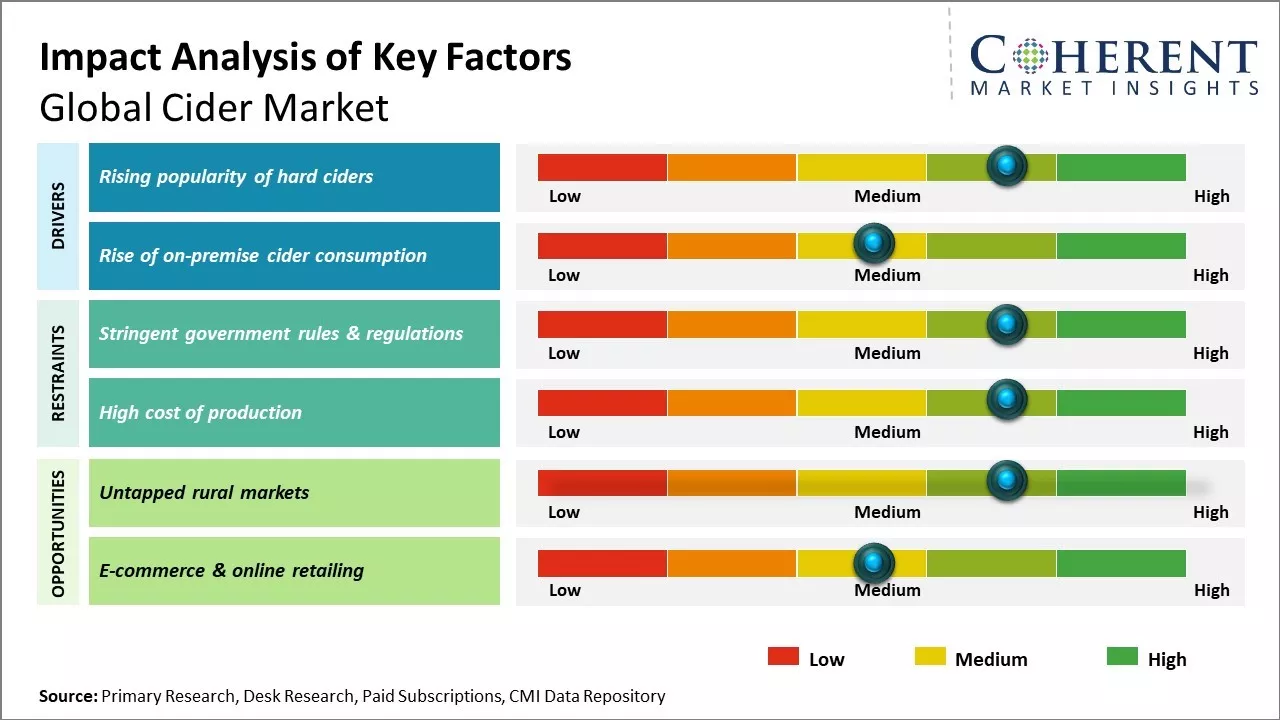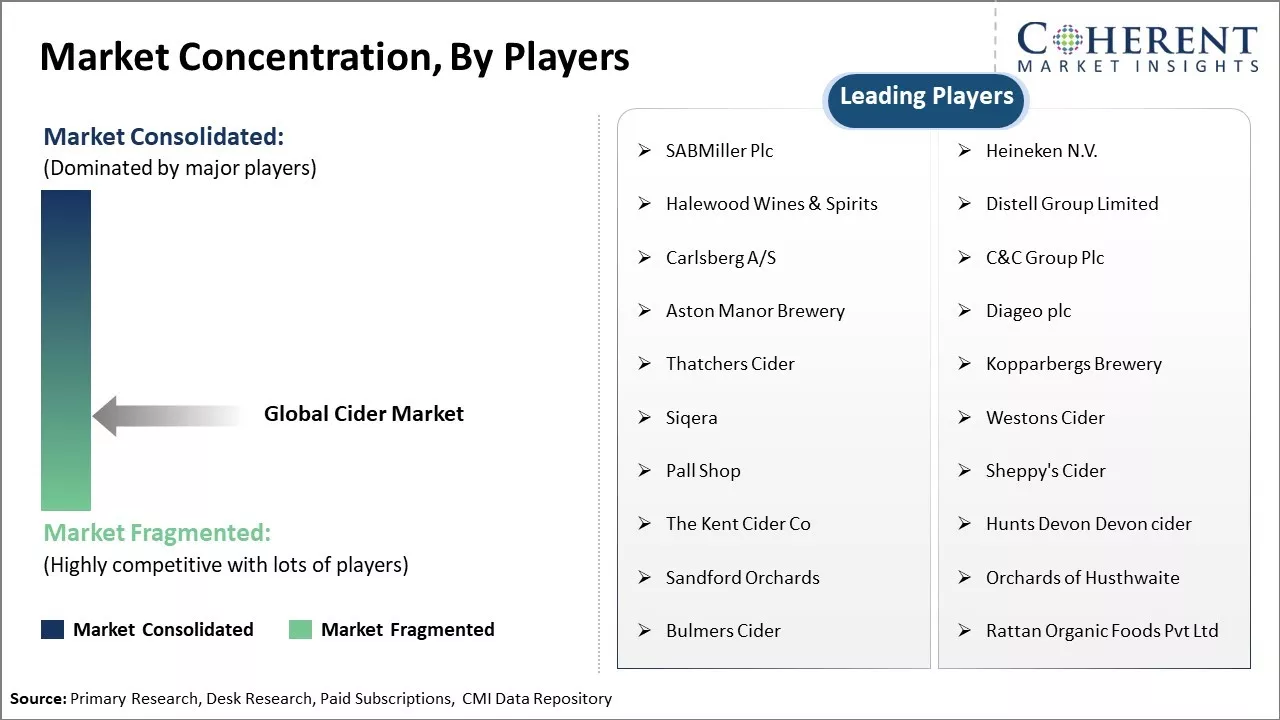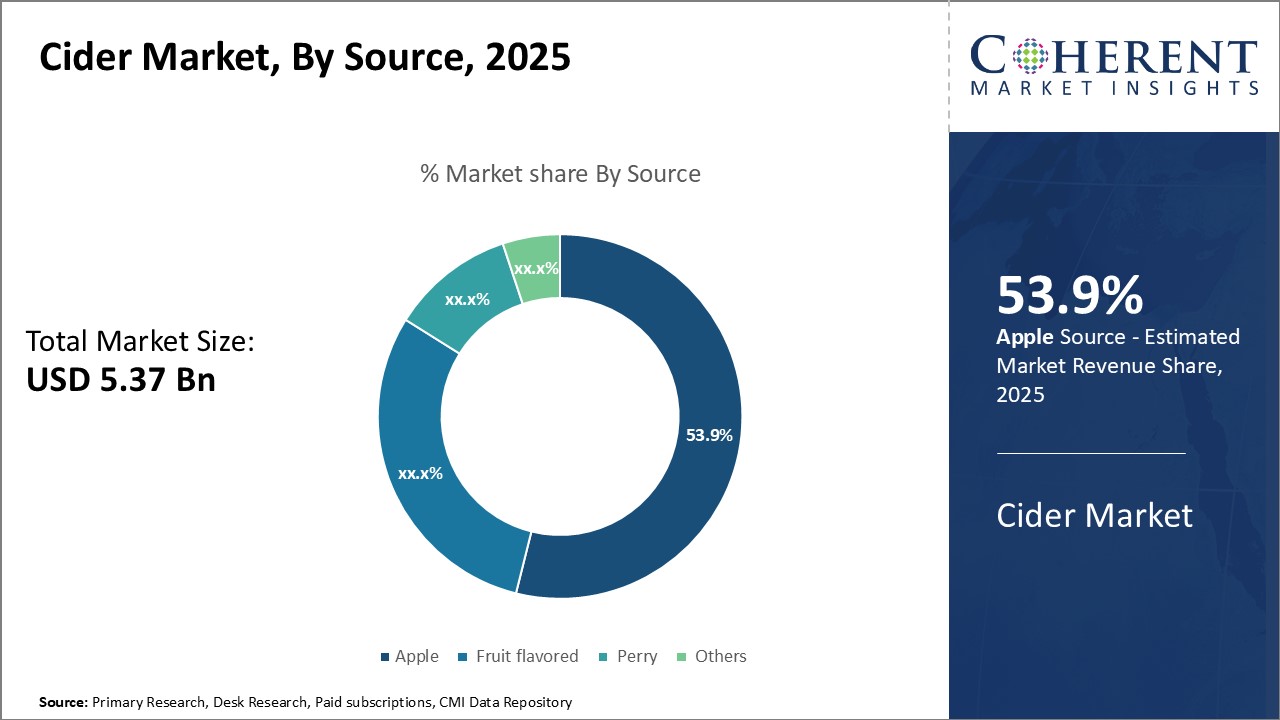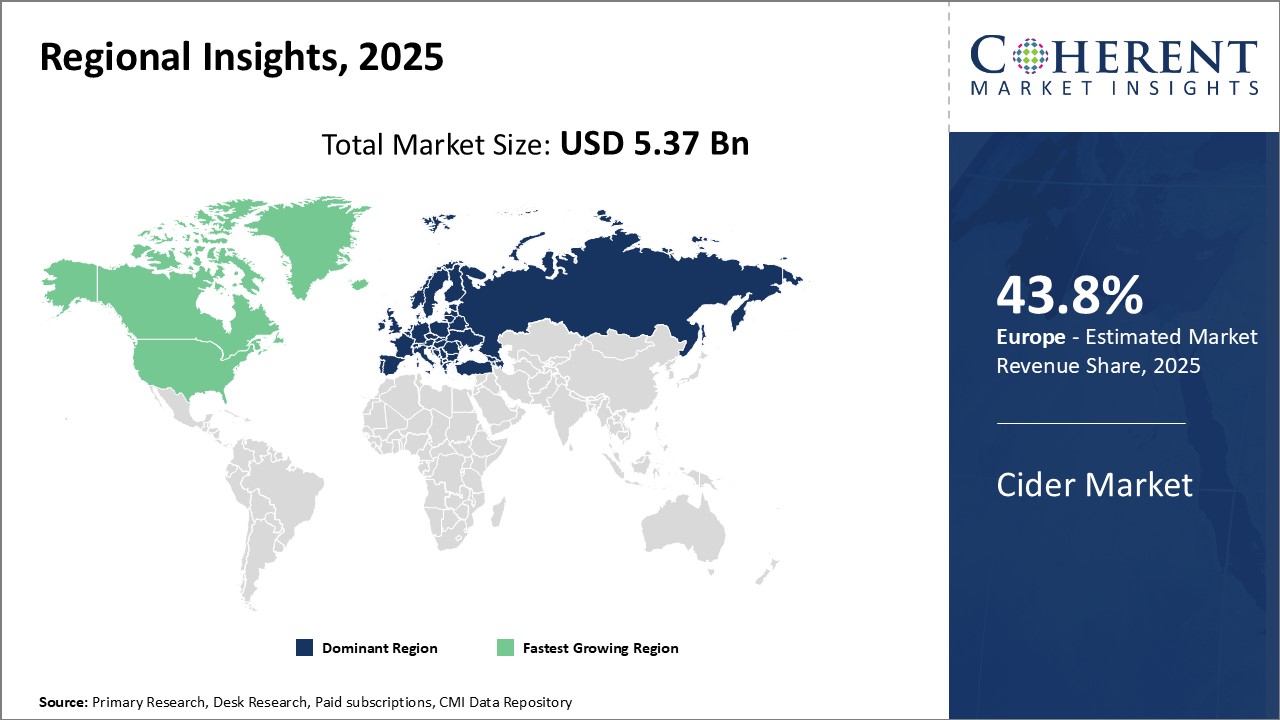The cider market is estimated to be valued at USD 5.37 Bn in 2025 and is expected to reach USD 6.75 Bn by 2032, exhibiting a compound annual growth rate (CAGR) of 3.3% from 2025 to 2032.

Discover market dynamics shaping the industry: Request sample copy
The global cider market has seen steady growth over the past few years and this trend is expected to continue during the forecast period from 2025 to 2032. Cider remains a popular alcoholic beverage choice around the world. While traditional cider-producing regions continue to account for a substantial portion of the global demand, other areas are starting to develop a taste for cider as well. Hard ciders and new premium product launches are boosting the category. Craft ciders are gaining popularity as consumers seek out locally-produced and more premium options.
Rising Popularity of Hard Ciders
In recent years, there has been growing interest in hard ciders among consumers in many countries. Where cider was once considered primarily as a regional drink, it is now gaining wider popularity and recognition as a premium beverage. Several trends have contributed to this increasing popularity of ciders.
There is a trend where consumers are more interested in exploring different types of drinks beyond the standard beer and wine offerings. Many young adults in particular see ciders as a refreshing alternative to beers that still offers an alcoholic beverage. The variety of flavors now available in ciders appeals to those seeking new tastes. Cider producers have innovated with flavors like pear, cherry, and even spiced or seasonal varieties. This has helped distinguish ciders from other categories and attract new customers.
Evolving health and wellness trends also favor ciders. While still alcoholic, ciders are often lower in calories, carbohydrates, and gluten compared to many beers. Some perceive ciders as a healthier indulgence. This benefits the category especially as more health-conscious consumers continue to emerge. Moreover, growing interest in locally produced and artisanal beverages has supported smaller craft cider producers. Customers like learning about different varieties made with distinct recipes and local ingredients. Regional ciders have become a point of local pride in the communities where they originate from.
Changing regulations have aided growth as well. In places where cider production was once heavily restricted, new rules allow greater access and commercial production. This helps address earlier supply constraints and encourages new cideries to form. Improved distribution networks further help expose customers to ciders beyond their initial region of popularity. Overall, ciders appear well-positioned to continue appealing to the broadening preferences of modern consumers seeking lower-alcohol beverages with variety, adventure, and local character.

Get actionable strategies to beat competition: Request sample copy
Rise of On-Premise Cider Consumption
While off-premise retail sales remain important for the cider market, on-premise consumption in restaurants and bars has shown strong gains in recent times. This could be another driver for future growth. Exposure to ciders through the on-premise channel helps boost awareness, trial and repeat purchasing. It also highlights ciders’ versatile pairing abilities with food in a social setting. On-premise establishments are recognizing cider’s rising popularity among customers and adding more options to their beverage menus.
Key Takeaways from Analyst:
The global cider market is expected to grow steadily over the next five years. The market is driven by the rising popularity of alcoholic ciders among millennial consumers who prefer drinks with lower alcohol content. Growing experimental attitude of young consumers towards different beverages is also fueling the trial of new cider flavors. However, stricter regulations on alcohol advertising and marketing across various countries may hamper quicker adoption of ciders.
Europe remains the dominant as well as the fastest growing region in the global cider market. Countries like the U.K., France, Spain and Germany have a strong cider drinking culture and consumers' preference for ciders over other alcoholic drinks continues to increase sales volumes. North America is also emerging as a promising market led by growing interest in ciders from the U.S. millennial and Gen Z consumers. Introduction of various fruit-infused and specialty ciders by regional as well as international brands is expanding choices for consumers.
On the product front, the market sees tremendous opportunities from premium and craft ciders which offer differentiated flavors and taste profiles. Innovation in cider flavors including exploration into fruit flavors beyond traditional apple and pear will further propel market revenues. Strategic partnerships between established cideries and leading food service retailers and grocery chains can help increase household penetration rates. Collaborations between cider makers and breweries may also introduce ciders to a broader consumer audience.
Market Challenges: Stringent government rules & regulations
Strict government regulations related to production, marketing and sales of cider products are limiting the expansion of the global cider market. Many countries have stringent norms regarding the amount of alcohol content allowed in cider beverages. For example, in India the alcohol content in cider cannot exceed 7.5% by volume. This low cap makes it difficult for cider makers to experiment with different fruit ingredients and flavors which impacts product innovation. Similarly, countries like China and Mexico have alcohol limits in the range of 5-6% that disincentivises new product development.
Market Opportunities: Untapped rural markets
Untapped rural markets in developing nations present a great opportunity for growth in the global cider market. With large agricultural populations and a growing middle class with rising disposable incomes, rural consumers in these regions are increasingly experimenting with new beverages. However, most commercial cider brands have traditionally focused their marketing and distribution efforts only within urban areas. There is now a unique chance for cider companies to enter new rural geographies and capture an emerging customer base. These consumers have traditionally consumed locally brewed alcoholic drinks. However, health awareness is increasing in villages and people are looking for commercially packaged beverage options with clearer quality standards and assurance. Cider's light taste makes it appeal to those shifting from heavy drinks. Its packaging in bottles or cartons also gives it an advantage over products sold in loose formats.

Discover high revenue pocket segments and roadmap to it: Request sample copy
Insights by Source: Popularity of Homemade Cider Drives the Apple Segment Growth
The apple segment is expected to contribute 53.9% share of the global cider market in 2025, owing to consumers' preference for homemade and authentic cider. Apples have long been used to make cider at home, imparting the drink with a natural, artisanal quality that consumers find appealing. Many view homemade apple cider as a more traditional beverage choice compared to ciders made from other fruits.
The farm-to-table and artisanal food trends have further boosted the demand for apple cider that resembles what people make at home. Many consumers see apple cider as reminiscent of simpler times and want to support local orchards and farms. The perception of apple cider being a more wholesome beverage choice compared to other alcohol options also appeals to health-conscious consumers. Additionally, many foodservice establishments have incorporated apple cider into their menus to cater to this consumer preference for naturally-brewed beverages seen as healthier indulgences. Recent years have witnessed a rise in small, independent cider makers that specialize exclusively in apple varieties and fermentation methods similar to homemade recipes. Their products have found popularity among consumers seeking authentic experiences. Larger cider producers have responded by highlighting the use of specific apple varieties and marketing their products as reminiscent of cider fresh from the farm. The emphasis on transparency regarding apple sourcing and minimal processing aligns well with prevailing interest in understanding product provenance.
Insights by Product Type: Sparkling Cider Takes the Top Spot in the Product Type Segment
Within the product type segment, sparkling cider is expected to claim the leading position with 36.1% of the market share in 2025. Sparkling varieties afford the refreshing effervescence and lower alcohol by volume that appeal to a wide consumer base including families and health-conscious individuals. The lightly carbonated nature of sparkling cider makes it suitable for social occasions as an alternative to beer or other alcoholic drinks.
Sparkling ciders are particularly popular as an affordable and lower-calorie choice for outdoor gatherings and events during summer months. Their fruity yet refreshing profile provides an enjoyable beverage that fits well with seasonal activities and cuisine. Many sparkling ciders are also gluten-free and vegan-friendly, further expanding their potential customer pool.
Additionally, sparkling ciders present opportunities for experimentation through flavor innovation that has helped boost the category in recent years. New flavor varieties like pear, grape and berry have added excitement while retaining cider's approachable qualities. Ready-to-drink canned options especially appeal to young consumers seeking convenient beverages for on-the-go consumption. As such, sparkling cider shows no signs of slowing down as the leading product type within the global cider market.

Need a Different Region or Segment? Customize now
The Europe region, particularly Western Europe, dominates the global cider market. Countries such as the U.K., Spain, France and Germany have a long history of cider production and consumption. Cider forms an important part of these countries' drinking culture and traditions. Europe is expected to account for over 43.8% share of the global cider market in 2025, due to strong domestic demand and a culture where cider is consumed widely on social and casual occasions. Major cider producing companies like Aspall, Strongbow and Bulmers are based in the U.K. and have a stronghold in their home markets as well as worldwide exports. The availability of domestic crab apples and pears, suitable production methods and establishment of cider houses over centuries has led to the region's dominance.
North America has emerged as the fastest growing regional market for cider globally. Major drivers of growth include the rising popularity of craft beverages and shift towards low alcohol drinks with variety in flavors. The U.S. is spearheading the North American cider renaissance led by growth in the micro-cider segment. Emerging craft producers are innovating with diverse ingredients beyond traditional apple and pear to cater to new consumers. Cideries in the Pacific Northwest region of the U.S. have gained prominence. Meanwhile, imports of European ciders like Strongbow and Magners are also rising in the U.S. and Canada due to increased availability and exposure. Growing cider fests and pub culture have boosted the category alongside collaborative initiatives between producers and distributors. The demand for unique packaged cider experiences is fueling growth across price segments in grocery aisles and liquor stores.
Cider Market Report Coverage
| Report Coverage | Details | ||
|---|---|---|---|
| Base Year: | 2024 | Market Size in 2025: | USD 5.37 Bn |
| Historical Data for: | 2020 To 2024 | Forecast Period: | 2025 To 2032 |
| Forecast Period 2025 to 2032 CAGR: | 3.3% | 2032 Value Projection: | USD 6.75 Bn |
| Geographies covered: |
|
||
| Segments covered: |
|
||
| Companies covered: |
SABMiller Plc, Heineken N.V., Halewood Wines & Spirits, Distell Group Limited, Carlsberg A/S, C&C Group Plc, Aston Manor Brewery, Diageo plc, Thatchers Cider, Kopparbergs Brewery, Siqera, Westons Cider, Pall Shop, Sheppy's Cider, The Kent Cider Co , Hunts Devon Devon cider, Sandford Orchards, Orchards of Husthwaite, Bulmers Cider, and Rattan Organic Foods Pvt Ltd |
||
| Growth Drivers: |
|
||
| Restraints & Challenges: |
|
||
Uncover macros and micros vetted on 75+ parameters: Get instant access to report
*Definition: The cider market caters to customers looking to purchase hard cider beverages. This market offers a variety of cider products made from fermented apple juice and other fruits. Popular options include traditional ciders made solely from apples as well as flavored ciders infused with berries, tree fruits, herbs, or spices. Products range from dry to sweet styles. Beyond alcoholic ciders, the cider market also carries non-alcoholic cider varieties, cider accessories like glasses and openers, as well as gift sets and merchandise related to the cider-making process and cider culture.
Share
Share
About Author
Yash Doshi is a Senior Management Consultant. He has 12+ years of experience in conducting research and handling consulting projects across verticals in APAC, EMEA, and the Americas.
He brings strong acumen in helping chemical companies navigate complex challenges and identify growth opportunities. He has deep expertise across the chemicals value chain, including commodity, specialty and fine chemicals, plastics and polymers, and petrochemicals. Yash is a sought-after speaker at industry conferences and contributes to various publications on topics related commodity, specialty and fine chemicals, plastics and polymers, and petrochemicals.
Missing comfort of reading report in your local language? Find your preferred language :
Transform your Strategy with Exclusive Trending Reports :
Frequently Asked Questions
Joining thousands of companies around the world committed to making the Excellent Business Solutions.
View All Our Clients
US Reciprocal Tax Impact Analysis On Cider Market
Stay updated on tariff changes with expert insights and timely information